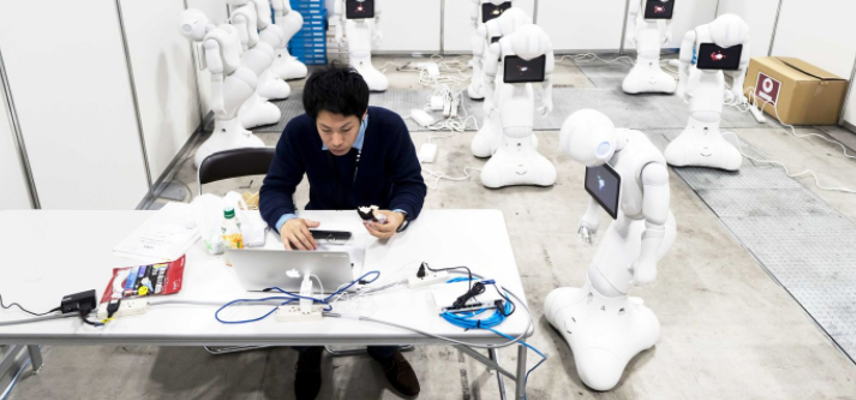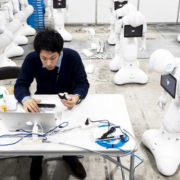For every job created by Amazon during the pandemic, there are 10 jobs losses in the brick and mortar retail sector.
That is happening as we speak.
The next phase of job losses will move up the value chain and hit those precious $100,000 per year jobs precisely because the advancement of technology will allow management to seamlessly substitute these highly paid workers with a digital or automated solution.
The evidence is starting to follow through.
In the last few days, ExxonMobil, Chevron (CVX), Charles Schwab, and Raytheon have announced plans to cut thousands of white-collar jobs.
Wells Fargo, Goldman Sachs, Salesforce (CRM), Allstate (ALL) and CNN owner WarnerMedia have already announced a massive wave of firings too.
Corporate America's belt-tightening provides more evidence of the fragile and unforgiving nature of this pandemic.
Global consultant McKinsey & Company forecasts over 800 million global workers could be replaced by robots by 2030.
The most exposed jobs on the cutting block consist of artificial intelligence (AI), a subset of automation where machines learn to use judgment and logic to complete tasks.
Stanford University doctoral candidate Michael Webb analyzed the data for 16,000 AI-related patents and more than 800 job descriptions and found that highly educated, well-paid workers will become more impacted by the spread of AI.
Bachelor’s degree holders would be exposed to AI over five times more than those with only a high school degree.
That’s because AI is especially superior at completing tasks that require planning, learning, reasoning, problem-solving, and predicting — most of which are skills required for white-collar jobs.
Other closely related jobs are in robotics and software and are likely to impact the physical and routine work of traditional blue-collar jobs.
This will sap the demand from everything from home buying and shopping to credit card defaults if a large swath of the U.S. population earns no income.
The rolling wave of white-collar layoffs is very impactful because this is the group that possesses the most purchasing power in the U.S. economy which is a consumption-driven economy.
Evidence is starting to pop up all over the board.
For instance, Charles Schwab (SCHW) said it would cut about 1,000 jobs following its takeover of TD Ameritrade.
Efficiencies, or the lack of it, have never been more magnified where companies are slashing redundant jobs upon mergers.
In the short term, white-collar workers have fared far better during the pandemic than blue-collar workers, who tend to be younger and have less education.
This is because white-collar workers have been able to operate from a home office where the bulk of blue-collar workers do not have that option.
But in the long term, technology through automation is also going to swallow up these higher-paid workers.
That is not to play down the trend of mass furloughs and layoffs in various industries, but technology and artificial intelligence will be deployed to cut high-paying jobs when it improves.
I believe that in 10 years or less, the technology will improve by leaps and bounds to the point where companies are able to install and scale it globally in an instant.
Those jobs will then go poof!
Nearly 40% of low-income workers lost their jobs in March and it is likely that the U.S. economy will never see that level of peak employment again.
Many people were rehired or found jobs elsewhere as the US economy reopened. After peaking at nearly 15% this spring, the unemployment rate has descended steadily, falling to 7.9% in September.
The mounting signs of white-collar job cuts cannot be ignored.
In another example, Allstate announced in late September that it would lay off 3,800 employees.
The insurance giant blamed the job cuts on the lack of driving during the pandemic and the refunds given to customers.
The pandemic resulted in fewer accidents, thus needing fewer claims people.
ExxonMobil (XOM) announced it will cut 1,900 jobs in the United States, mostly at its headquarters in Houston.
A broader reorganization by Exxon will slash 14,000 jobs by the end of 2022.
Energy companies have been disproportionately impacted because the demand shock has halved oil revenues.
This list goes on and on as Raytheon (RTN) disclosed it will lay off 4,000 contractors, mostly engineers, as well as 1,000 corporate employees.
And that's on top of Raytheon previously announcing plans to lay off 15,000 employees because of the downturn in the aviation industry.
Government, local and federal, has to confront a massive loss of revenues which will affect its ability to hire and maintain government workers.
Layoffs could rise among government workers because the pandemic has set off an epic budget crunch at states and local municipalities.
Eventually, whether it's 5 or 10 years down the line, the next set of solutions will inherently lead to the A word which every employee dreads – Automation.
Going 100% remote means face to face communication has slowed down to a crawl and management is less inclined to reward employees who “put on a good face” and for the sake of their own survival have turned to employees that perform well.
There will be an ultimate race to the bottom with spiraling wages and human workers unable to justify their place when competing with machines.
This inevitably leads into the world of analytics to management part of the staff for better or worse and many companies have gone from all to nothing in an instant.
I know this is a lot of information to process, but the ones getting on board with the new normal will thrive and the ones late to implement the necessary measures will flounder.
2020 has been a strange year, and get ready for new twists and turns in the last two months.
Each ensuing year will most likely get weirder because of the heavy introduction of automation into human lives.





